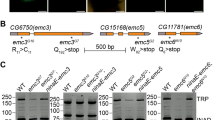Abstract
MUTATIONS of the Drosophila melanogaster ninaA gene affect phototransduction: ninaA mutant flies have a 10-fold reduction in the levels of rhodopsin in the R1–R6 photoreceptor cells1,2. The ninaA gene was isolated and found to encode a 237-amino-acid protein that has over 40% amino-acid sequence identity with the vertebrate cyclosporin A-binding protein, cyclophilin, a protein that seems to be involved in T-lymphocyte activation. The remarkable evolutionary conservation of cyclophilin in two phylogeneti-cally distant organisms and its involvement in diverse transduction processes suggests that this protein plays an important role in cellular metabolism. Indeed, cyclophilin has recently been shown to be a prolyl cis–trans isomerase that catalyses, in vitro, rate-limiting steps in the folding of a number of proteins3,23. Here, we present evidence for the involvement of cyclophilin-like molecules in a defined cellular process. The availability of mutations in a cyclophilin gene provides a new model system for the study of cyclophilin and cyclosporin action.
This is a preview of subscription content, access via your institution
Access options
Subscribe to this journal
Receive 51 print issues and online access
$199.00 per year
only $3.90 per issue
Buy this article
- Purchase on Springer Link
- Instant access to full article PDF
Prices may be subject to local taxes which are calculated during checkout
Similar content being viewed by others
References
Larrivee, D. C., Conrad, S. Stepheson, R. S. & Pak, W. L. J. gen. Physiol. 78, 521–545 (1981).
Stephenson, R. S., O'Tousa, J., Scavarda, N. J., Randall, L. L. & Pak, W. L. in The Biology of Photoreception (eds Cosens, D. J. & Vince-Price, D.), 477–501 (Cambridge University Press, 1983).
Fischer, G., Wittmann-Liebold, B., Lang, K., Kiefhaber, T. & Schmid, F. X. Nature 337, 476–481 (1989).
Hall, J. C. Q. Rev. Biophys. 15, 223–479 (1982).
Heisenberg, M. & Wolf, R. in Vision in Drosophila: Genetics of Microbehavior, Studies of Brain Function Vol. 12 (ed. Braitenberg, V). (Springer, Berlin, 1984).
Zuker, C. S., Mismer, D., Hardy, R. & Rubin, G. M. Cell 53, 475–485 (1988).
Sved, J. Drosoph. Info. Serv. 73, 169 (1986).
Handschumacher, R. E., Harding, M. W., Rice, J., Drugge, R. J. & Speicher, D. W. Science 226, 544–547 (1984).
Merker, M. M. & Handschumacher, R. E. J. Immun. 132, 3064–3070 (1984).
Harding, M. H., Handschumacher, R. E. & Speicher, D. W. J. biol. Chem. 261, 8547–8555 (1986).
Koletsky, A. J., Harding, M. W. & Handschumacher, R. E. J. Immun. 137, 1054–1059 (1986).
Borel, J. F., Feurer, C., Gubler, H. & Stahelin, H. Agents and Actions 6, 468–475 (1976).
Cohen, D. J., et al. Ann. intern. Med. 101, 667–682 (1984).
Shevach, E. M. A. Rev. Immun. 3, 397–423 (1985).
Drugge, R. J. & Handschumacher, R. E. Transplant Proc. 20, Suppl. 2, 301–309 (1988).
Second International Congress on Cydosporine, Transplant Proc. 20, Suppl. 2 (1988).
International Symposium on the Mechanism of Action of Cyclosporine Transplantation 46, 1S (1988).
Manger, B., Hardy, K. J., Weiss, A. & Stobo, J. D. J. clin. Invest. 77, 1501–1506 (1986).
Szamel, M., Berger, P. & Resch, K. J. Immun. 136, 264–269 (1986).
Rosoff, P. M. & Terres, G. J. Cell Biol. 103, 457–463 (1986).
Rubin, G. M. Trends Neurosci. 8, 231–233 (1985).
Rubin, G.M. Science 240, 1452–1459 (1988).
Ostroy, S. E., Wilson, M. & Pak, W. L. Biochem. biophys. Res. Commun. 59, 960–966 (1974).
Davis, M. M. et al. Proc. natn. Acad. Sci. U.S.A. 81, 2194–2198 (1984).
Maniatis, T., Fritsch, E. F. & Sambrook, J. in Molecular Cloning, A Laboratory Manual (Cold Spring Harbor Laboratory, New York, 1982).
Sanger, F., Nicklen, S. & Coulson, A. R., Proc. natn. Acad. Sci. U.S.A. 74, 5463–5467 (1977).
Haendler, B., Hofer-Warbinek, R. & Hofer, E. EMBO J. 6, 947–950 (1987).
Danielson, P. E. et al. DNA 7, 261–267 (1988).
Takahashi, N., Hayano, T. & Suzuki, M. Nature 337, 473–475 (1989).
Author information
Authors and Affiliations
Rights and permissions
About this article
Cite this article
Shieh, BH., Stamnes, M., Seavello, S. et al. The ninaA gene required for visual transduction in Drosophila encodes a homologue of cyclosporin A-binding protein. Nature 338, 67–70 (1989). https://doi.org/10.1038/338067a0
Received:
Accepted:
Issue Date:
DOI: https://doi.org/10.1038/338067a0
This article is cited by
-
In vivo identification of Drosophila rhodopsin interaction partners by biotin proximity labeling
Scientific Reports (2024)
-
Systematic analysis of the maize cyclophilin gene family reveals ZmCYP15 involved in abiotic stress response
Plant Cell, Tissue and Organ Culture (PCTOC) (2017)
-
Expression of a cyclophilin OsCyp2-P isolated from a salt-tolerant landrace of rice in tobacco alleviates stress via ion homeostasis and limiting ROS accumulation
Functional & Integrative Genomics (2015)
-
Cyclophilin A: a key player for human disease
Cell Death & Disease (2013)
-
Loss of all three calreticulins, CRT1, CRT2 and CRT3, causes enhanced sensitivity to water stress in Arabidopsis
Plant Cell Reports (2013)
Comments
By submitting a comment you agree to abide by our Terms and Community Guidelines. If you find something abusive or that does not comply with our terms or guidelines please flag it as inappropriate.



